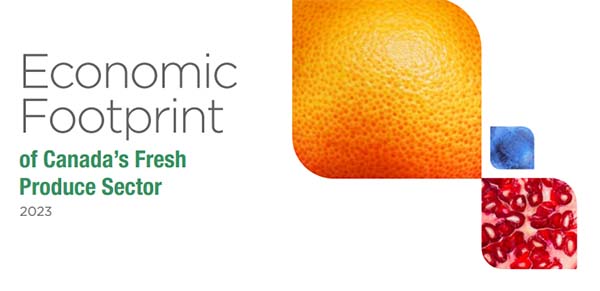A new economic impact report on the produce industry in Canada has just been released by the Conference Board of Canada. It provides a fascinating big-picture outlook on the industry’s role in the economy. Download a copy here.
Some findings:
“The sector has the largest economic impact on Ontario, followed by Quebec, British Columbia, and the Maritime provinces,” the report notes.
The fresh produce sector’s total contribution to GDP in 2022 was nearly $15 billion in 2019 dollars. (I am assuming that all the figures in this report are in Canadian dollars.)
The total number of jobs produced, directly or indirectly, by the produce sector in 2022 was over 185,000, up from 181,600 given in the previous report, from 2017.
The northern nation’s short growing season means that it has to rely on imports: “Approximately eighty cents of every dollar spent on fresh produce in Canada is spent on imported products. Most fresh produce imports come from the United States followed by Mexico.”
But Canada also exports about half of its fresh produce, the largest destination being the United States.
In 2022, farm-gate values for vegetables rose by 11.2 percent to nearly $1.6 billion, while fruit sales increased by 15.3 percent, to $1.4 billion in 2022 over 2021.
Nevertheless, per-capita availability of fresh fruits and vegetables declined by 5.1 percent to 72.9 kilograms per capita, because of a 16.8 percent growth in exports and a 3.6 percent reduction in imports.
Food inflation remained high, and “produce inflation has particularly hit Canadians hard. Compared to 2021, prices for fresh vegetables including potatoes were up 10.4 percent and fresh fruit prices were up 8.3 percent in 2022.” As a result, Canadians are increasibly substituting frozen for fresh produce.
Farm prices were correspondingly higher: 6.7 percent for fresh fruit in 2022 over the previous year, 6 percent for potatoes, and 5.5 percent for fresh vegetables.
But these increases did not keep up with input costs, which rose by 18.5 percent over the previous year, meaning that “44 per cent of respondents reported selling at a loss, and 77 per cent indicated they have not been able to increase their selling price in line with their costs.” Surprisingly, perhaps, the biggest impact of the produce industry on employment was in retail trade, which accounted for 57,490 jobs nationwide; crop and animal production came second, at 49,261 jobs; and wholesale trade came third, accounting for 6,325 jobs



